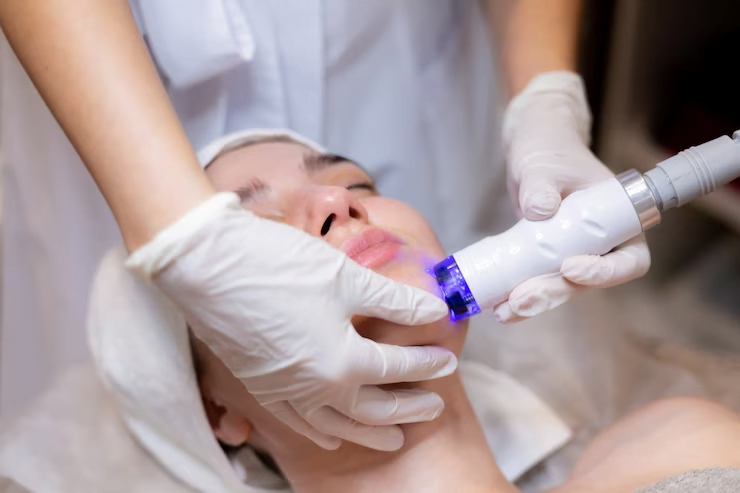Table of Contents
ToggleWhen it comes to achieving smooth and flawless skin, many individuals struggle with unwanted facial hair. While there are various methods available for hair removal, facial laser hair removal has gained popularity due to its effectiveness and long-lasting results. This article will delve into the details of facial laser hair removal, discussing its benefits, procedure, aftercare, and potential side effects.
Understanding Facial Laser Hair Removal
Facial laser hair removal is a cosmetic procedure that uses laser technology to target and remove unwanted hair from the face. The laser emits a concentrated beam of light that is absorbed by the pigment in the hair follicles, thereby damaging them and inhibiting future hair growth. The procedure is commonly used to remove hair from the upper lip, chin, cheeks, and forehead, providing individuals with smoother and hair-free skin.
Benefits of Facial Laser Hair Removal
- Long-lasting results: Unlike temporary hair removal methods like waxing or shaving, facial laser hair removal offers long-lasting results. After a series of sessions, many individuals experience permanent hair reduction, allowing them to enjoy smooth skin for an extended period.
- Precision: Laser technology enables precise targeting of unwanted hair while leaving the surrounding skin undamaged. This precision is particularly crucial when treating sensitive areas of the face, ensuring safety and minimizing the risk of skin irritation.
- Time-saving: Constantly dealing with facial hair can be time-consuming. Facial laser hair removal offers a time-saving solution by reducing the need for frequent hair removal routines. Individuals can save valuable time in their daily beauty regimen and focus on other activities.
- Reduced ingrown hairs: Ingrown hairs can be a common problem associated with traditional hair removal methods. Facial laser hair removal minimizes the occurrence of ingrown hairs, providing smoother and blemish-free skin.
The Facial Laser Hair Removal Procedure
- Consultation: Before undergoing permanent facial hair removal, it is essential to have a consultation with a qualified dermatologist or a trained aesthetician. They will assess your skin type, hair color, and medical history to determine if you are a suitable candidate for the procedure.
- Preparation: Prior to the treatment, the area to be treated will be cleaned and shaved. It is recommended to avoid sun exposure and the use of tanning products for a few weeks before the procedure.
- Eye protection: Both the patient and the practitioner will wear protective eyewear during the procedure to shield their eyes from the laser light.
- Laser application: The practitioner will use a handheld laser device to deliver controlled pulses of laser light to the targeted areas of the face. The laser light is absorbed by the hair follicles, damaging them and inhibiting future hair growth. The procedure may cause a mild tingling or stinging sensation, but it is generally well-tolerated.
- Multiple sessions: Facial laser hair removal typically requires multiple sessions to achieve optimal results. The number of sessions varies depending on factors such as hair thickness, hair color, and skin type. Generally, sessions are scheduled 4 to 6 weeks apart to target different stages of hair growth.
Aftercare and Side Effects
- Aftercare: After the facial laser hair removal session, it is essential to follow the aftercare instructions provided by the practitioner. These may include avoiding sun exposure, using sunscreen, and refraining from harsh skincare products or treatments for a few days.
- Temporary side effects: Some individuals may experience temporary side effects after facial laser hair removal. These can include redness, swelling, and mild discomfort in the treated area. These side effects typically subside within a few hours or days.
- Rare side effects: While rare, potential side effects of facial laser hair removal can include skin discoloration, scarring, blistering, or changes in skin texture. It is crucial to choose a reputable and experienced practitioner to minimize the risk of these complications.
Factors to Consider
- Hair and Skin Color: As mentioned earlier, facial laser hair removal is most effective for individuals with dark hair and fair to medium skin tones. This is because the laser targets the melanin pigment in the hair follicles. If you have lighter hair or darker skin, alternative hair removal methods or specific laser devices may be recommended.
- Hormonal Factors: Hormonal imbalances can contribute to excessive facial hair growth, particularly in women. In such cases, it is important to address the underlying hormonal issues in conjunction with facial laser hair removal to achieve long-term results.
- Pre-existing Skin Conditions: Individuals with certain skin conditions, such as active acne, eczema, or psoriasis, may need to postpone facial laser hair removal until their skin condition improves. It is crucial to inform your practitioner about any existing skin conditions during the consultation.
Areas of Application
Facial laser hair removal can target various areas of the face, including:
- Upper Lip: Unwanted hair on the upper lip can be a significant concern for many individuals, particularly women. Laser hair removal effectively eliminates this hair, providing a smooth and hair-free upper lip area.
- Chin: Excessive or coarse hair on the chin can be frustrating. Chin laser hair removal can specifically target the hair follicles in this area, resulting in a clean and hair-free chin.
- Cheeks: Some individuals may have unwanted hair growth on their cheeks, which can be distressing. Laser hair removal can effectively target these hairs and provide smoother and more even-toned cheeks.
- Forehead: Unwanted hair on the forehead can be a source of self-consciousness. Facial laser hair removal can treat this area, ensuring a smooth and hair-free forehead.
Who Is a Suitable Candidate?
Facial laser hair removal is generally suitable for individuals with fair to medium skin tones and dark hair. The laser technology primarily targets the melanin in the hair follicles, making it less effective for individuals with blonde, gray, or white hair. Consulting with a dermatologist or aesthetician is crucial to determine if you are a suitable candidate for the procedure.
Conclusion
Facial laser hair removal offers a reliable and effective solution for achieving smooth and hair-free skin on the face. By considering factors such as hair and skin color, addressing hormonal factors, and selecting the appropriate treatment areas, individuals can enjoy long-lasting results. While there are alternative hair removal methods available, laser hair removal stands out due to its precision, long-term effectiveness, and convenience. Consult with a qualified professional to determine the best approach for your specific needs and enjoy the confidence of a hair-free face.

